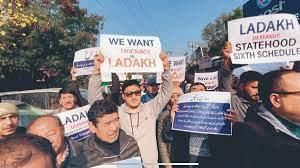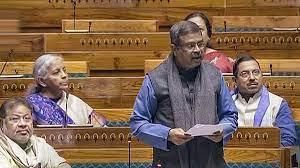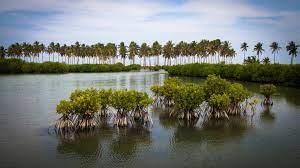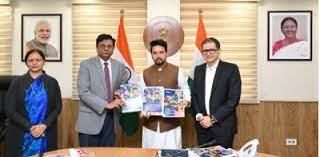Weekly Current Affairs (8th to 14th February 2024) Part - 2 | General Test Preparation for CUET UG - CUET Commerce PDF Download
Report on Climate and Catastrophe Insight
- Aon plc, renowned across more than 120 countries and sovereignties, specializes in providing counsel and solutions encompassing commercial, reinsurance, retirement, health, and data & analytic services. Their overarching mission revolves around guiding decisions for the betterment of individuals worldwide, safeguarding and enhancing lives.
Key Report Highlights:
Escalating Damages and Unprecedented Events:
- The year 2023 witnessed a staggering 398 notable natural disasters, resulting in a whopping USD 380 billion in economic losses, surpassing previous estimates and marking the hottest year on record. This underscores the pressing need for enhanced disaster preparedness, risk mitigation, and bolstered resilience.
Weather-Related Influences and Vulnerabilities:
- An overwhelming 95% of the natural disasters in 2023, leading to damages exceeding USD 1 billion, were attributed to weather-related factors. Ranging from scorching heatwaves to severe storms and seismic activities, these events underscore the imminent threat posed by catastrophic risks to both lives and livelihoods.
Protection Gap and Insurance Coverage:
- Insurance payouts amounted to only USD 118 billion, covering a mere 31% of the total damages incurred, highlighting a significant "protection gap" of approximately 69%, up from 58% in 2022. While most disaster losses in the US were covered, the majority in other regions—Americas (Non-US), Europe, Middle East, Africa (EMEA), and Asia and Pacific (APAC)—remained uninsured. APAC exhibited the widest protection gap at 91%, followed by non-US Americas and EMEA at 87%.
Global and Regional Insights:
- United States: Economic losses from natural disasters soared to USD 114 billion, with insurance offsetting 70% of the damages. Severe convective storms (SCS) contributed substantially to the financial toll.
- Americas (Non-US): Insurance coverage addressed only USD 6 billion of the USD 45 billion in economic losses, with Hurricane Otis in Mexico's southern Pacific coast emerging as the costliest individual event.
- Europe, Middle East, and Africa (EMEA): The region grappled with USD 150 billion in economic losses stemming from devastating earthquakes, notably the Turkey and Syria earthquake.
- Asia and Pacific: Economic losses amounted to USD 65 billion, with a glaring 91% protection gap. Floods in China and New Zealand incurred significant insured losses, while a protracted heatwave affected several countries in South and Southeast Asia.
Recommendations:
- Urgent calls are made to utilize climate analytics as proactive tools providing insights into a spectrum of extreme events.
- Organizations, spanning from insurers to high-impact sectors like construction, agriculture, and real estate, are urged to leverage forward-looking diagnostics to analyze climate trends, mitigate risks, and safeguard their workforces.
- The insurance industry is urged to assume a pivotal role in mobilizing and expediting capital flow into green investments and volatility management through innovative risk transfer initiatives.
What is the Significance of Disaster Preparedness, Risk Management, and Resilience-Building?
- Disaster Preparedness: It refers to proactive measures taken before a disaster occurs to enhance readiness and response.
- Early Warning Systems: Preparedness involves setting up efficient early warning systems. These systems provide timely alerts about impending disasters (e.g., cyclones, floods, earthquakes), allowing people to evacuate and take necessary precautions.
- Training and Drills: Regular training sessions and mock drills prepare emergency responders, healthcare professionals, and the public to handle crises effectively.
- Stockpiling Supplies: Preparedness includes stockpiling essential supplies (food, water, medicines) to meet immediate needs during disasters.
- Community Awareness: Educating communities about disaster risks and preparedness measures fosters a culture of safety and resilience.
- Risk Management: It involves identifying, assessing, and mitigating risks associated with disasters.
- Risk Assessment: By analysing vulnerabilities, exposure, and potential impacts, risk management helps prioritise actions.
- Risk Reduction Strategies: Implementing structural (e.g., building codes) and non-structural (e.g., land-use planning) measures reduces vulnerability.
- Financial Protection: Insurance and risk financing mechanisms provide financial resilience against losses.
- Climate Adaptation: Risk management integrates climate change adaptation strategies to address evolving risks.
- Resilience-Building: Resilience refers to a community’s ability to bounce back after a disaster.
- Social and Psychological Resilience: Strengthening social networks, community cohesion, and mutual support enhances resilience. Mental health support and coping mechanisms help individuals recover from trauma.
- Economic and Infrastructural Resilience: Diversifying livelihoods, promoting local businesses, and creating employment opportunities contribute to economic resilience. Building robust infrastructure (roads, bridges, utilities) that can withstand shocks is vital.
- Environmental Resilience: Conserving ecosystems (forests, wetlands) contributes to overall resilience.
What is the Role of Insurance Coverage in Mitigating Economic Losses?
Safety Net in Difficult Times:
- High Inflation and economic volatility can lead to unexpected financial losses and during such periods, insurance acts as a safety net.
- For instance, repairing or rebuilding damaged property is now more expensive due to increased costs of building materials and services. Labour shortages and disrupted supply chains can further delay repairs.
- Insurance coverage ensures that individuals and businesses are financially protected against such losses. Without coverage (or with inadequate coverage), the financial burden can be devastating.
Increased Risk Awareness:
- Financial shocks prompt consumers to become more cautious and aware of risks.
- Insurance companies can capitalise on this by emphasising their value in managing inflation risk and providing financial security.
- By offering timely payouts, insurers help businesses and individuals recover faster, allowing economic activities to resume after catastrophes.
Economic Development and Stability:
- Insurance turns accumulated capital into productive investments. It enables businesses to mitigate losses, maintain financial stability, and promote trade and commerce activities.
- A robust insurance sector contributes to sustainable economic growth.
Disaster Mitigation and Risk Reduction:
- Insurance companies increasingly contribute to disaster mitigation by encouraging policyholders to invest in risk reduction measures. By incentivizing long-term thinking, insurers play a role in reducing overall risks.
- For example, PMFBY (Pradhan Mantri Fasal Bima Yojana) offers financial protection to farmers against crop losses due to natural calamities such as droughts, floods, cyclones, pests, and diseases.
- By providing timely compensation for crop damages, PMFBY helps farmers recover from losses and reduces their vulnerability to economic shocks triggered by disasters.
Conclusion
Investing in disaster preparedness, risk management, and resilience-building is not only a matter of protecting lives and livelihoods in the short term but also crucial for ensuring the long-term sustainability and prosperity of communities in an increasingly uncertain world.
Ladakh’s Statehood Demand
Understanding Ladakh's Key Demands:
- Background: Following the division of the erstwhile state of Jammu and Kashmir into two Union Territories in August 2019, Ladakh found itself navigating its new administrative status, prompting calls for enhanced autonomy and preservation of its cultural and demographic heritage.
- Primary Demands: Spearheaded by two socio-political groups, the movement advocates for protections previously provided under Article 370 and 35A. Their core demands encompass:
- Statehood for Ladakh: A push to elevate Ladakh from its current Union Territory designation to a full-fledged state, granting it heightened political autonomy and decision-making authority.
- Inclusion under the 6th Schedule: Urging for constitutional safeguards under the 6th Schedule to safeguard the cultural, linguistic, and land rights of the indigenous populace.
- Job Reservations: Advocating for job reservations to ensure employment opportunities for Ladakh's youth, fostering equitable access to economic resources and prospects.
- Creation of Distinct Parliamentary Constituencies: Proposing the establishment of separate Parliamentary constituencies for Leh and Kargil, recognizing the distinctive demographic and geographic characteristics of each region.
- Engagement by the Ministry of Home Affairs (MHA): The MHA has initiated a high-powered committee to engage with Ladakh's representatives, underscoring the government's commitment to address the region's concerns.
What are the Imperatives Behind Ladakh's Current UT Status?
- Cultural and Demographic Differences: Prior to its designation as a UT, Ladakh was part of the state of Jammu and Kashmir.
- Ladakh's Buddhist majority contrasted significantly with the Muslim-majority population of the erstwhile state of J&K.
- This difference often translated into concerns about resource allocation, political representation, and cultural preservation.
- Security Considerations: Ladakh borders sensitive regions like Pakistan and China, making strategic importance a significant factor.
- Establishing it as a union territory allowed for more direct and streamlined administration from the central government in security matters.
- Developmental Perspective: The Indian government likely saw creating the union territory of Ladakh as a way to address long-standing grievances, improve administrative efficiency, and expedite development in the region.
What are the Constitutional Provisions Related to Formation of States in India?
- Article 3 of the Indian Constitution grants Parliament the authority to undertake various actions regarding the formation, alteration, or dissolution of states. These actions include:
- Formation of New States: Parliament can create a new state by separating territory from an existing state, uniting two or more states, or combining any territory with a part of an existing state.
- Increase or Decrease in State Area: Parliament has the power to increase or diminish the area of any state.
- Alteration of State Boundaries: Parliament can alter the boundaries of any state.
- Change of State Name: Parliament can change the name of any state.
Conditions under Article 3:
- A bill proposing such changes must be introduced in either house of the Parliament only with the prior recommendation of the President.
- Before recommending the bill, the President must refer it to the concerned state legislature to express its views within a specified period.
Additional Consideration:
- Parliament's authority to form new states includes the ability to create a new state or union territory by uniting a part of any state or union territory with another state or union territory.
- Parliament is not obligated to adhere to the views of the state legislature and may accept or reject them, even if received on time.
- For union territories, no reference needs to be made to the concerned legislature, and Parliament can take any action it deems appropriate.
- Therefore, India is an indestructible union of destructible states.
What is the Sixth Schedule?
- Overview: The Sixth Schedule encompasses special provisions tailored for the governance of tribal areas within four northeastern states, namely Assam, Meghalaya, Tripura, and Mizoram, as delineated under Article 244(2) of the Indian Constitution.
- Objectives: It endeavors to safeguard tribal lands and resources, curtailing their transfer to non-tribal entities, while also shielding tribal communities from exploitation, thus preserving and promoting their cultural and social identities.
- Autonomous Districts and Regions: Within these states, tribal areas are designated as Autonomous Districts, with provisions allowing the Governor to partition districts into Autonomous Regions in cases where various Scheduled Tribes cohabit an autonomous district.
- The Governor holds authority to organize, reorganize, and modify the boundaries or names of autonomous districts as deemed necessary.
- District and Regional Councils: Each autonomous district is mandated to establish a District Council comprising a maximum of 30 members, of whom no more than 4 are nominated by the Governor, while the remainder are elected via adult suffrage.
- Similarly, each designated autonomous region is accompanied by a separate Regional Council.
Bills to Include PVTGs to ST List in Odisha and AP
Understanding Voice Vote:
- This procedure involves the Speaker presenting a question to the house, followed by members expressing their opinion through "ayes" (yes) or "noes." The Speaker gauges the volume of support and opposition to determine whether the motion passes or fails.
Overview of the Bills and Their Proposals:
- Andhra Pradesh: The Constitution (Scheduled Tribes) Order (Amendment) Bill, 2024 seeks to amend the Constitution (Scheduled Tribes) Order, 1950, pertaining to Andhra Pradesh. It proposes the addition of specific Particularly Vulnerable Tribal Groups (PVTGs) to the state's ST list, including Bondo Porja, Khond Porja, and Konda Savaras.
- Odisha: The Constitution (Scheduled Castes and Scheduled Tribes) Orders (Amendment) Bill, 2024 modifies the Constitution (Scheduled Castes) Order, 1950, and the Constitution (Scheduled Tribes) Order, 1950, to revise the SC and ST lists in Odisha. Notable amendments include the addition of Pauri Bhuyan, Paudi Bhuyan, Chuktia Bhunjia, Bondo community, Mankidia community to the ST list, alongside the inclusion of Muka Dora and Konda Reddy tribes. Additionally, the bill reclassifies Tamadia and Tamudia communities from SCs to STs.
What is the Significance of these Bills?
- These amendments aim to address disparities in the recognition of certain tribes across different regions.
- For instance, communities like Konda Reddy and Muka Dora were acknowledged as Scheduled Tribes (ST) in Andhra Pradesh but faced discrimination in Odisha.
- By including these groups in the ST list, these bills aim to rectify longstanding inequalities, ensuring fair access to government provisions and services.
- Particularly Vulnerable Tribal Groups (PVTGs) listed as STs gain access to reservation quotas in education, employment, and political representation, thereby enhancing their socio-economic status.
- The ST status guarantees affirmative action in educational institutions, enabling PVTG students to compete on an equal footing with others.
Understanding Particularly Vulnerable Tribal Groups (PVTGs):
Overview:
- PVTGs are a subset of Scheduled Tribes considered more vulnerable than regular Scheduled Tribes, established by the Indian Government to enhance their welfare.
- India has 75 PVTGs, with Odisha having the highest number at 13, followed by 12 in Andhra Pradesh.
- Article 342(1) of the Indian Constitution empowers the President, with consultation from the Governor (in the case of a state), to specify tribes, tribal communities, or groups within tribes as Scheduled Tribes in a state or union territory.
- Parliament holds the authority to include or exclude tribes or tribal communities from the list of Scheduled Tribes specified under Article 342(1) through legislation. Once specified, a tribe or tribal community remains on the list unless Parliament decides otherwise.
Initiatives Supporting PVTGs:
- PM-JANMAN
- Janjatiya Gaurav Divas
- Viksit Bharat Sankalp Yatra
- PM PVTG Mission
Building An Inclusive Society Through SMILE
Who is a Transgender?
- According to the Transgender Persons Act of 2019, a transgender individual is someone whose gender does not align with the gender assigned to them at birth.
- This definition encompasses individuals with intersex variations, those who identify as gender-queer, and individuals with socio-cultural identities such as kinnar, hijra, aaravani, and jogta.
- India's 2011 Census marked the first time in its history that the population of transgender individuals was included, estimating that 4.8 million Indians identified as transgender.
What is the SMILE Scheme?
Overview:
- The SMILE Scheme is a newly launched initiative resulting from the merger of existing schemes targeting beggars and transgender individuals.
- The scheme comprises two sub-schemes: the 'Central Sector Scheme for Comprehensive Rehabilitation for the Welfare of Transgender Persons' and the 'Central Sector Scheme for Comprehensive Rehabilitation of those Engaged in Begging,' providing holistic welfare and rehabilitation measures to these communities.
- It leverages existing shelter homes provided by State/UT Governments and Urban local bodies for the rehabilitation of transgender individuals. In cases where such shelter homes are unavailable, new dedicated ones will be established by implementing agencies.
Focus:
- The scheme primarily focuses on rehabilitation, offering medical facilities, counseling, basic documentation, education, skill development, and economic linkages, among other services.
- It aims to benefit approximately 60,000 individuals living in extreme poverty, enabling them to lead lives of dignity.
- Scholarships are provided to transgender students in Class 9 and above, extending up to post-graduation, to support their education completion.
- It includes provisions for skill development and livelihood under the PM-DAKSH scheme.
- Through Composite Medical Health, it offers a comprehensive package, in conjunction with the Pradhan Mantri Jan Aarogya Yojana (PM-JAY), supporting Gender-Reaffirmation surgeries through selected hospitals.
- The 'Garima Greh' housing facility ensures food, clothing, recreational activities, skill development opportunities, and medical support to transgender individuals and those engaged in begging.
Implementation:
- The scheme will be implemented with the collaboration of State/UT Governments/Local Urban Bodies, Voluntary Organizations, Community-Based Organizations (CBOs), institutions, and others.
- The provision of a Transgender Protection Cell in each state will oversee offenses, ensuring timely registration, investigation, and prosecution.
- A National Portal & Helpline will offer necessary information and solutions to transgender individuals and those engaged in begging when required.
Scheme for Comprehensive Rehabilitation of Transgenders:
- The scheme has been piloted in select cities with significant concentrations of the beggar and transgender communities.
- During the 2019-20 period, the Ministry allocated Rs. 1 crore to the National Institute of Social Defence (NISD) and Rs. 70 lakh to the National Backward Classes Finance & Development Corporation (NBCFDC) for skill development programs for beggars.
What Challenges Do Transgenders Face?
Social Stigma:
- Social Exclusion: Transgender individuals frequently encounter isolation and marginalization, resulting in mental health issues, substance abuse, and a diminished quality of life.
- Stereotyping and Misrepresentation: Society often stereotypes transgender individuals, restricting their access to employment, education, and healthcare opportunities.
- Family Rejection: Many transgender individuals face rejection from their families, depriving them of familial support and financial stability.
Discrimination:
- Violence and Hate Crimes: Hate crimes, physical and verbal abuse, and sexual assault pose significant threats to the safety and well-being of transgender individuals.
- Educational Barriers: Discrimination within educational institutions obstructs access to quality education and future career prospects.
- Employment Discrimination: Transgender individuals frequently encounter discrimination in the workplace, resulting in unemployment or underemployment and perpetuating their economic vulnerability.
- Healthcare Disparities: Discrimination by healthcare providers often dissuades transgender individuals from seeking necessary medical care, including gender-affirming procedures.
Lack of Legal Recognition:
- Legal Ambiguity: Despite the enactment of the Transgender Persons (Protection of Rights) Act, 2019 in India, legal uncertainties and gaps persist and require attention.
- Transgender individuals are not adequately defined, and the Act lacks provisions for self-determination of gender.
- Lack of Comprehensive Policies: The absence of comprehensive policies addressing gender identity, non-binary genders, and a clear legal framework for transgender rights remains a challenge.
- Implementation Gaps: Existing laws are often ineffectively implemented due to a lack of awareness, prejudice, and reluctance on the part of authorities.
What Initiatives Exist for Transgender Persons?
A memorandum of understanding (MoU) has been established with the National Health Authority to issue a specialized Ayushman Bharat TG Plus card, providing over 50 health benefits to transgender individuals, including gender reassignment and cosmetic treatments.
- The Swachh Bharat Mission (Urban) has incorporated provisions for dedicated toilets for transgender persons in its policy guidelines.
- The National Portal for Transgender Persons has been established.
- The Transgender Persons (Protection of Rights) Rules, 2020 have been enacted.
- The National Council for Transgender Persons has been formed.
- Certificates of Identity are being issued.
- Equal Opportunity Policies are being developed.
What Further Steps Can Be Taken to Support Transgender Persons?
- Transgender-Inclusive Policies: Legal and law enforcement systems need to be empowered and sensitized to the issues faced by the transgender community.
- A more inclusive approach for transgender individuals must be planned and adopted by the government and society.
- Efforts should be made to allay their grievances of exclusion from policy formulation or decision-making processes, and opportunities for their public participation should be increased.
- Addressing Social Concerns: Provision of free legal aid, supportive education, and social entitlements must be ensured for the transgender community at the ground level, as suggested by the NALSA Judgment.
- Separate policies related to healthcare must be formulated and communicated in all private and public hospitals and clinics.
- Awareness and acceptance of the transgender community need to be increased.
- Financial Security: Liberal credit facilities and financial assistance must be ensured to support their career as entrepreneurs or businessmen, similar to the SHG-Bank Linkage Programs.
- Transgender Individuals in Prisons: Awareness and documentation are crucial for addressing reforms in reference to sexual minorities, especially transgender prisoners.
The Commonwealth Human Rights Initiative's recommendations for a gender-fluid approach to the treatment of transgender prisoners should be considered by the Union government to develop a 'model policy' addressing their special needs, through a consultative process with members of the transgender community, to honor the mandate of the NALSA judgment.
Safeguarding Children in Digital Spaces
What Challenges Do Children Face in Digital Spaces?
Cyberbullying: Cyberbullying involves using digital platforms to harass, threaten, or harm others, especially peers.
Manifestations:
- It can take various forms, including abusive messages, spreading rumors, posting hurtful comments or embarrassing content, impersonation, or exclusion from online groups.
Impacts:
- Cyberbullying can severely affect children's mental health, self-esteem, academic performance, and social relationships. It may lead to anxiety, depression, isolation, self-harm, or even suicide.
Online Sexual Exploitation and Abuse: This entails using digital platforms to engage children in sexual activities or expose them to inappropriate content for the gratification or profit of offenders.
Forms:
- Activities may include producing or distributing child sexual abuse material, grooming children for sexual purposes, soliciting sexual acts, livestreaming abuse, or sextortion.
Effects:
- Such exploitation can cause lasting physical, psychological, and emotional harm to children, potentially leading to lifelong trauma and damage.
Privacy and Data Protection:
- This involves children's right to control their personal information online, including its collection, use, sharing, or storage.
Violations:
- Tech companies, advertisers, hackers, or other third parties may breach this right by collecting, using, or selling children's data without their consent for commercial or malicious purposes.
Consequences:
- Such breaches can result in identity theft, fraud, targeted marketing, manipulation, discrimination, or exposure to inappropriate or harmful content or contacts.
Digital Literacy and Citizenship:
- This refers to children's ability and responsibility to use digital platforms effectively, safely, and ethically, and to engage as informed and active online citizens.
Challenges:
- Children face challenges due to the prevalence of misinformation, disinformation, and hate speech online, which can mislead, confuse, or harm them and erode trust and values.
Consequences:
- Digital literacy may suffer due to disparities in access, affordability, or quality of digital platforms and technologies, leading to digital divides and inequalities among children.
Metaverse and Virtual Reality (VR):
- The metaverse is a virtual world utilizing virtual reality and augmented reality to provide lifelike online experiences.
Manifestations:
- Virtual environments can be exploited by predators and scammers, fostering cyberbullying, discrimination, and privacy violations.
Negative Impacts:
- Children may encounter graphic or violent content, leading to desensitization or emotional distress, impacting their well-being.
Generative Artificial Intelligence (AI):
- Generative AI creates new content based on patterns from existing data, presenting educational benefits but also risks like creating persuasive disinformation and fake content.
Forms:
- While offering educational and creative opportunities, it can also generate convincing fake images, videos, or information, posing risks to children's cognitive vulnerabilities.
What Can Be Done to Keep Children Safe Online?
Prevention:
- Cyberbullying can be prevented and addressed by educating children about online etiquette and empathy, encouraging them to report any incidents, supporting the victims, and holding the perpetrators accountable.
- Teaching children about responsible VR usage, digital citizenship, and online safety.
- Digital literacy and citizenship can be enhanced by teaching children how to access, evaluate, create, and share online content, how to communicate and collaborate online, and how to respect and protect themselves and others online.
Tech Companies' Role:
- Tech firms must prioritize 'safety by design(SBD)', acknowledging their role in safeguarding children's well-being online, as highlighted in recent Congressional hearings.
- SBD puts user safety and rights at the centre of the design and development of online products and services. It focuses on the ways technology companies can minimise online threats by anticipating, detecting and eliminating online harms before they occur.
- UNICEF recommends that tech companies apply the highest existing data protection standards to children’s data in the metaverse and virtual environments.
Government Responsibilities:
- Assess and adjust regulatory frameworks like the Child Abuse Prevention and Investigation Unit regularly to prevent violations of children's rights in digital spaces.
- Develop innovative initiatives like a child online safety toolkit, to help parents, educators, and other concerned adults protect children from online dangers.
- Utilize regulatory power to combat harmful content and behaviour affecting children online.
Collective Responsibility:
- Recognize that existing real-world rules for child protection should extend to the online realm.
- Emphasize the importance of collaboration between tech companies, governments, and organizations to ensure child safety online.
UN World Restoration Flagships
What are the 7 World Restoration Flagships recently Recognized by the UN?
The Restoring Mediterranean Forests Initiative:
- Implemented by Lebanon, Morocco, Tunisia, and Türkiye.
- This initiative adopts an innovative approach aimed at safeguarding and restoring natural habitats and vulnerable ecosystems.
- Over 2 million hectares of forests have been restored since 2017, with a target of exceeding 8 million hectares by 2030.
The Living Indus Initiative:
- Formally endorsed by the Pakistan parliament following the climate change-induced floods of 2022.
- Launched officially at the 27th Conference of Parties to the UN Framework Convention on Climate Change in Sharm el-Sheikh.
- Aims to restore 25 million hectares of the Indus river basin by 2030, recognizing the Indus River as a living entity with rights.
The Acción Andina Social Movement:
- Spearheaded by the non-profit Andean Ecosystems Association (ECOAN), seeking to safeguard and restore one million hectares of Andean forests.
- Focuses on securing land titles for local communities and shielding the forests from mining and timber exploitation.
The Sri Lanka Mangrove Regeneration Initiative:
- A community-driven program emphasizing the restoration of ecological equilibrium in mangrove ecosystems.
- Achievements include the restoration of 500 hectares of mangroves since its inception in 2015, with a goal of restoring 10,000 hectares by 2030.
The Terai Arc Landscape (TAL) Initiative:
- Geared toward revitalizing the forests of critical corridors within the TAL, with the involvement of local communities and various stakeholders.
- Spans an 810 km stretch between the river Yamuna and the river Bhagmati, covering parts of India and Nepal.
- Aims to restore 350,000 hectares of forests by 2030, benefiting around 500,000 households in Nepal.
Regreening Africa’s Agriculture:
- Focuses on increasing carbon storage, enhancing crop and grass yields, and fortifying soil resilience through natural fertilization.
- Aimed at supporting sustainable agricultural practices and mitigating climate change effects.
Growing Forests in Africa's Drylands Initiative:
- Seeks to expand restoration efforts from 41,000 to 229,000 hectares by 2030, engaging African farmers in planting millions of trees annually.
- Envisages creating over 230,000 jobs, contributing to sustainable development in the region.
What are UN World Restoration Flagships?
About:
- The World Restoration Flagships are part of the UN Decade on Ecosystem Restoration led by the UN Environment Programme (UNEP) and the Food and Agriculture Organization of the UN (FAO) which aims to prevent, halt, and reverse the degradation of ecosystems on every continent and in every ocean.
- The UN General Assembly has declared 2021–2030 as the UN Decade on Ecosystem Restoration.
- The UN recognizes the World Restoration Flagships through the World Restoration Flagship Award.
- This award is part of the UN Decade on Ecosystem Restoration, spearheaded by UNEP and FAO, which aims to counteract ecosystem degradation across all continents and oceans.
- Recipients of this award become eligible for technical and financial assistance from the UNO.
- The awards track notable initiatives following global commitments to restore one billion hectares (an area larger than China).
Significance:
- Global recognition and celebration of their restoration success stories.
- Technical and financial support of up to USD 500,000 per selected initiative (only for developing countries).
- Attraction of global attention and investments.
- Feature in the UN Decade’s publications, campaigns, outreach, advocacy, and education efforts.
- Listing in the UN Secretary-General’s Report to the General Assembly.
Potential of India’s AVGC-XR Sector
What is the Outlook of India’s AVGC-XR Sector?
Industry Landscape:
- India boasts a thriving ecosystem comprising over 4,000 studios, with major hubs located in Mumbai, Bengaluru, Pune, Hyderabad, and Chennai. Moreover, there's a noticeable surge in studio establishments in smaller towns, indicating the sector's widespread expansion.
- Leveraging India's rich cultural heritage, diverse art forms, and skilled artists, the industry is primed for substantial value creation and employment generation.
Employment:
- Primary job opportunities will emerge for content developers, animators, pre- and post-production artists, pre-visualization artists, compositors, among others.
- With certain segments within AVGC-XR already growing at an annual rate of 30 or 35%, the industry is experiencing rapid growth.
Projected Growth:
- Currently employing 2.6 lakh individuals, the AVGC-XR sector aims to generate 23 lakh direct jobs by 2032, with revenues expected to skyrocket to over USD 26 billion by 2030 from the current USD 3 billion.
- Although India's contribution to the global AVGC-XR sector stands at a mere 0.5%, government data suggests the potential to capture 5% (USD 40 billion) of the global market share by 2025, creating over 1,60,000 new jobs annually and growing at a rate of 25-30% annually.
What are the Challenges Associated to AVGC Sector?
Lack of Authentic Data:
- The absence of reliable data on employment, industry size, and educational institutions hampers decision-making processes within the AVGC sector.
Skill Gap in Education and Employment Sector:
- Developing the AVGC ecosystem necessitates a skilled workforce proficient in various roles such as animators, developers, designers, localization experts, and product managers.
Infrastructure Constraints:
- Insufficient training infrastructure compromises the quality of education provided to students, thereby affecting the caliber of talent available for the AVGC industry.
Less focus on Research Development:
- There's a pressing need to foster research initiatives specific to the AVGC-XR sector to encourage dedicated exploration and innovation.
Absence of an AVGC Academic Reference Point:
- Unlike other sectors such as engineering, design, and management, India lacks a premier institute specializing in AVGC education.
Availability of Funds:
- The absence of dedicated funding sources impedes the growth of the AVGC sector in India.
Lack of Globally-Popular Indian IPs:
- The AVGC sector suffers from a dearth of original Indian intellectual property, as much of the work is outsourced. Encouraging local production with incentives and concessions can help boost the creation of indigenous IPs.
What are the Government Initiatives to Promote the AVGC-XR Sector?
Educational Integration:
- The National Education Policy (NEP) 2020 has integrated creative arts, design, and sports into the school curriculum from Class 6 onwards, fostering a conducive environment for nurturing talent in AVGC-XR.
- Around 5,000 CBSE and state board schools have introduced AVGC-XR learning, with plans for expansion nationwide. This initiative aims to redefine animation as a form of family entertainment suitable for all ages.
Policy Framework:
- To unleash the scope of the AVGC sector, Union Budget 2022-23 announced for setting up of an AVGC Promotion Task Force to recommend ways to realise and build domestic capacity for serving Indian markets and the global demand.
- Collaborative efforts between industry bodies like FICCI, ABAI (Association of Bangalore Animation Industry), SAIK (Society of AVGC Institutions in Kerala), and government entities are underway to formulate robust policies tailored to each state.
- States like Karnataka, Maharashtra, and Telangana have already implemented proactive measures to support the sector's growth.
Way Forward
- Continued emphasis on skill development programs tailored to the AVGC-XR industry is essential. This includes both formal education initiatives integrated into school curriculums and vocational training programs to equip aspiring professionals with the necessary skills.
- Foster closer collaboration between industry players and educational institutions to ensure that curriculum and training programs are aligned with industry needs. Internship opportunities, guest lectures, and industry-sponsored projects can bridge the gap between academia and industry.
|
164 videos|800 docs|1160 tests
|
FAQs on Weekly Current Affairs (8th to 14th February 2024) Part - 2 - General Test Preparation for CUET UG - CUET Commerce
| 1. What is the significance of Ladakh's statehood demand? |  |
| 2. How will including PVTGs to the ST list in Odisha and AP benefit these communities? |  |
| 3. What is SMILE and how does it aim to build an inclusive society? |  |
| 4. How can children be safeguarded in digital spaces? |  |
| 5. What are the UN World Restoration Flagships and what is their goal? |  |




























